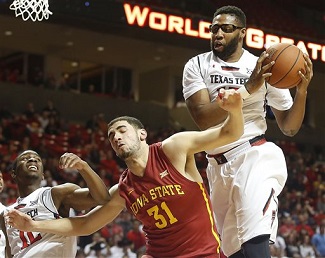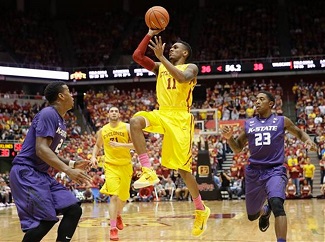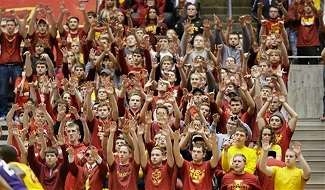Hilton Coliseum | Ames, IA | Tip: 8 P.M. CT | TV: ESPN Vegas: Iowa State -5.5 | KenPom: Iowa State, 72-70 (61%)
With a long list of contenders lining up in the preseason to knock Kansas off its perch atop the conference, college basketball analysts hesitantly predicted that perhaps this was finally the season in which the Jayhawks might not take home a piece of the league title. History would make it hard to bet against the champs, but with such a deep stable of challengers, for once “the field” seemed to at least be an even favorite. However, in the span of just a few hours on Saturday, the landscape of this year’s Big 12 race quickly shifted, putting Kansas back in its familiar spot in the driver’s seat.
Texas Tech shocked Iowa State in Lubbock on Saturday First, the Texas Longhorns let a second-half lead slip away as Kansas put on a clinic at the Frank Erwin Center, with the Jayhawks excecuting to near-perfection on the offensive end. A few hours later and a few hours up the road, Iowa State fell victim to the Lubbock pothole that trips up at least one team annually. Just like that, the Cyclones conceded the edge they had claimed with a home win over KU only a week prior, and the Jayhawks were once again all alone atop the Big 12. Saturday’s losses make tonight’s Big Monday contest even more important for both Iowa State and Texas. If the Cyclones want to keep pace with the Jayhawks and position themselves to take advantage of any KU stumbles, they cannot afford any losses at home. We are only a third of the way through the Big 12’s meat-grinder schedule, and it’s true that a lot can happen in the next six weeks. Still, history and a strong home-court advantage at Phog Allen Fieldhouse both indicate that Kansas will give Iowa State little margin for error. For Texas, the depth of the Big 12 might make it a battle just to reach .500 in league play. The Longhorns have already dropped two home games, and their recent results do not give fans reason for optimism on the road. Texas is just 10-19 on the road since the league switched to a double round-robin format, with six of those 10 wins coming against Texas Tech and TCU. With the Longhorns already logging road wins against the Red Raiders and Horned Frogs this season, it means they must win the rest of their home games to reach .500, or at least steal enough road wins against the league’s laundry list of Top 25 teams to make up for any more home losses. If the road struggles for Texas weren’t enough to make tonight’s task a daunting one for the Horns, Hilton Coliseum has also proven to be one of the nation’s toughest venues for visiting opponents. Since the arrival of Fred Hoiberg in Ames, home crowds have consistently been at capacity, with noise levels through the roof. That has made home wins for Iowa State nearly automatic, as the Cyclones have posted a 27-3 mark at Hilton Coliseum since the advent of the Big 12’s double round-robin. By the Numbers Clocking in at 70.7 adjusted possessions per game, the Cyclones boast the nation’s 13th-quickest tempo. Iowa State doesn’t use high-pressure defense to force turnovers and turn the game into a track meet, but they instead constantly look up after defensive rebounds and baskets by the opponents. Cyclone shooters drift to the arc as the the ball is quickly moved up the floor, frequently allowing them to strike before defense has even thought about setting up. The Cyclones take 29.6% of their shots in transition, the ninth-highest percentage in Division I, according to Hoop-Math. That ability to quickly score also helps the Cyclones on the defensive glass. Despite being much smaller than most of their opponents, the Cyclones are currently ranked 40th in the nation when it comes to winning defensive rebounds. Opponents are usually so concerned with preventing transition baskets by Iowa State that they will not commit rebounders on the offensive end, turning many possessions into one-and-done affairs. When teams do manage to stop Iowa State from scoring in transition, they can still find it tough to prevent points in the half-court. The Cyclones do not turn the ball over, with their 16.1% turnover rate one of the 25 best in the land. Iowa State moves the ball quickly and will keep a defense scrambling until they find an easy look at the rim or a shooter with space. Thanks to their crisp passing and disciplined offense, the Cyclones log assists on more than 63% of their buckets, currently the 15th-best rate in the country. Meet the Cyclones
Point guard Monté Morris can do it all for Iowa State Although all of the Cyclones are good passers with nice assist totals, it’s point guard Monté Morris (No. 11) that leads the way in that department. Morris is perhaps the nation’s most underrated floor general, having posted an assist-to-turnover ratio of more than 5-to-1 this season. He is incredibly calm under pressure, as evidenced in Iowa State’s road win against West Virginia. Despite constant trapping and a variety of defensive looks, Morris posted six assists against one turnover, looking the part of an unflappable hostage negotiator every time the Mountaineers rushed at him in the backcourt. A big part of the reason why Morris is able to facilitate so well is his ability to create off the bounce. He can quickly get into the paint and create shots for himself, but is always looking for his open teammates camped out in the corner or leaking out to the wings. Morris is also a defensive pest, posting a steal rate just shy of 3% while only being whistled for 1.6 fouls per 40 minutes. The Cyclone that most benefits from Morris’ ability to draw defensive attention with the bounce is sharpshooter Naz Long (No. 15). The 6’4″ junior is the team’s best three-point threat, having drained more than 40% of his attempts this season. Long lives on the perimeter, with nearly 77% of his attempts coming from beyond the arc, but is not afraid of putting the ball on the deck and driving to the tin when a defender closes out too aggressively. If there’s one thing that Coach Hoiberg is known for, it might be his dance moves. But if there’s a second thing Hoiberg is known for, it would be his ability to mesh a group of transfers to create a solid team. This season, he has a trio of contributing transfers, led by former USC and UNLV scorer Bryce Dejean-Jones (No. 13). Although the 6’6″ senior takes about three shots behind the arc each game, he’s at his best attacking the basket. Dejean-Jones is very athletic and can score in bunches, as evidenced by the 17-plus points he averaged in his first eight games as a Cyclone. Big 12 teams have done a much better job at limiting his output, but he’s still always a threat to go off for double-digit scoring. Perhaps the most unheralded player on the Cyclone roster is 6’6″ forward Dustin Hogue (No. 22). Even though Hogue only typically takes one or two three-pointers per game, he has made almost 50% of his attempts, so defenses have to be honest when he’s behind the arc. That outside threat pulls opposing defenders out to the perimeter, and it also allows him to beat bigs off the bounce and get to the rack for a layup. Despite his size, Hogue is a phenomenal rebounder, particularly on the offensive end. His timing is impeccable once a shot goes up, even when he’s on the perimeter. Watch Hogue after he passes to an open shooter, and you’ll notice that he immediately breaks towards the rim, quickly finding cracks between the defenders to get position and win back any misses. At just 6’8″, junior Georges Niang (No. 31) is the closest thing to a post in Iowa State’s offense. He is an outstanding passer that can break down zones from the high post, and he is also incredibly slippery when beating opposing bigs in face-up situations. Although Niang has struggled inside against the likes of Oklahoma State’s Michael Cobbins and the big frontline of Baylor, his versatility and court vision make him invaluable. One newcomer who may some increased minutes tonight is 6’9″ junior Jameel McKay (No. 1). The forward became eligible at the semester break, having transferred from Marquette without ever playing a game for the Golden Eagles. McKay is a long and lanky forward who does a fantastic job protecting the rim, and his rebounding rates on both the offensive and defensive ends are tops in the Iowa State rotation. The junior has averaged 22.1 minutes in his nine appearances, but will likely be called on for additional duty against the size of Texas. Abdel Nader (No. 2) is yet another transfer for the Cyclones, arriving by way of Northern Illinois. Nader plays much bigger than his 6’6″ frame, but still has serviceable handles that he can use to attack from the wings. He has taken more than 44% of his shots from behind the arc, but has made jut 22.9% of them. Nader is a strong 6’6″ and a solid rebounder, so he would likely be better served by focusing on his interior game and exploiting mismatches when isolated against other wings near the paint. The final member of Iowa State’s rotation is sophomore three-point gunner Matt Thomas (No. 21), who is averaging about 17 minutes per game. He’s taken more than two-thirds of his shots from beyond the arc, but has struggled through a sophomore slump this year, connecting on less than 30% of them. Fortunately, Thomas showed an ability to put the ball on the floor, create shots, and get to the rim in a breakout performance against Oklahoma State, so he can still contribute for the Cyclones even when his long-range shot isn’t there. Keys to the Game 1. Limit transition points – The Longhorns have the second-best transition defense in terms of effective field-goal percentage, per Hoop-Math. Texas is also one of the nation’s better teams in terms of limiting transition opportunities altogether, as opponents take just 17.2% of their shots in the first 10 seconds of a possession. Those two stats will be key in slowing down Iowa State tonight, but a commitment to stopping the break could also cost the Longhorns their usual edge on the offensive glass. Coach Rick Barnes is typically not one to change his system based on opponent, so it may be up to the Texas guards to get back in a transition prevent, while the big Texas frontcourt continues to attack the offensive glass. 2. Pressure outside shooters – Iowa State might not be making threes at the rate that they have enjoyed in recent years, but the Cyclones still have enough dangerous shooters to make the perimeter a key battleground tonight. Iowa State had a tough time scoring inside against the size of Baylor, and will likely face the same difficulty tonight. If the Longhorns can rely on their bigs to patrol the paint and alter shots down low, they can then afford to push their guards and wings closer to the perimeter and challenge Iowa State’s long-range shooters. A failure to get hands up in front of the Cyclone shooters, might just get Texas run out of the building. 3. Attack inside – This may be easier said than done, as Iowa State found quite a bit of success against both Oklahoma State and West Virginia with a sagging man-to-man that made it very difficult to get the ball down low. Texas has seen its share of that kind of defense this season, and the Horns have typically not fared well against it. However, if the Longhorns can manage to find some room in the post and pound the ball down low, they will not only exploit their size advantage, but also potentially put a very thin Iowa State frontcourt in foul trouble.
Cyclone Alley makes Hilton Coliseum an intimidating venue 4. Survive runs – With Iowa State’s up-tempo approach and its rabid home crowd, the Cyclones can quickly go on a scoring run that dazes their visiting opponents. It would be nearly impossible for the Longhorns to play a full 40 minutes tonight without seeing at least one of those scoring outbursts from ISU, so the Longhorns must weather those runs and respond in kind. If they can survive the scoring spurts and try to win the small battles between media timeouts, the Longhorns should be able to keep it close with an Iowa State team that has won its four conference games by an average of just 3.75 points. When on the road in conference play, being within striking distance in the final minutes is often all you can ask for. [Ed: This post was revised after publishing to reflect the new rankings in the January 26th polls.] |











